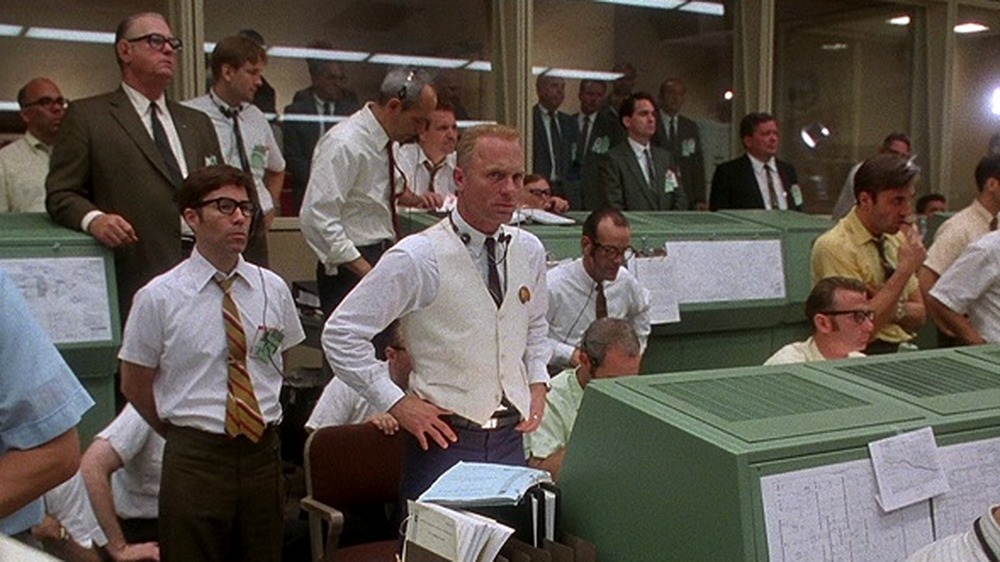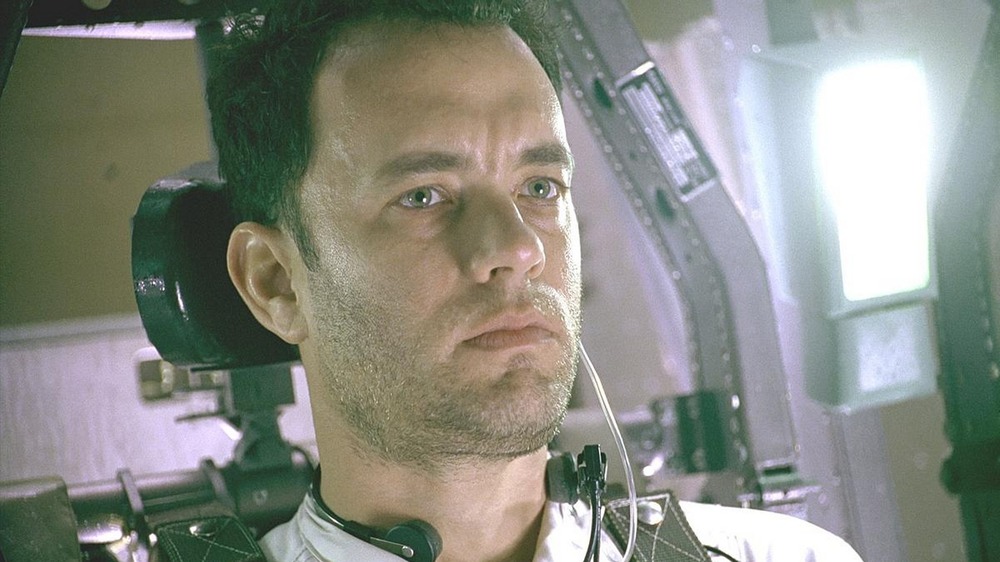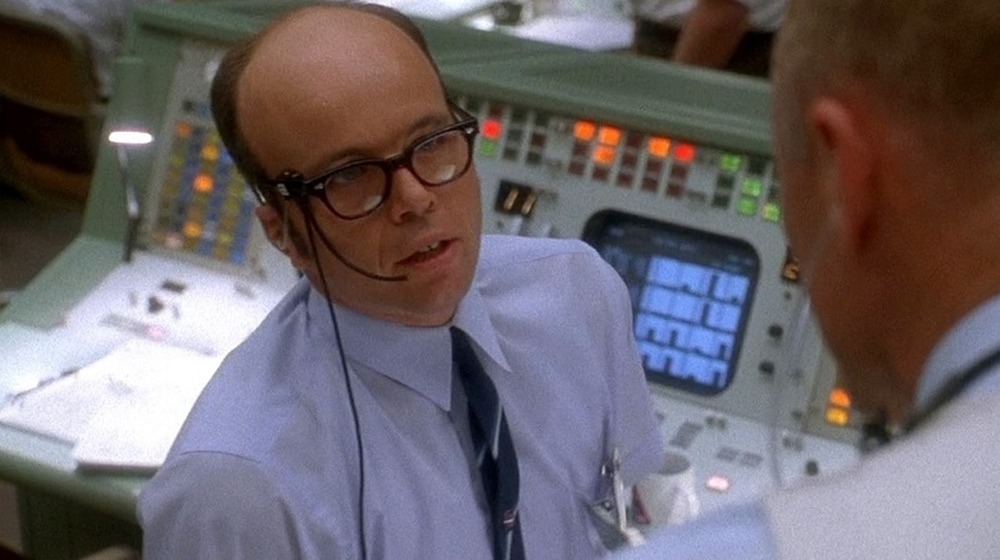The Untold Truth Of Apollo 13 The Movie
Released in 1995, Apollo 13 was a huge hit, both critically and financially. It was nominated for nine Oscars and won two of them. It made over $350,000,000 worldwide, establishing itself as a big hit in the U.S. and internationally. It's about the true story of the three-man crew that was supposed to be the third group of men who walked on the moon in 1970. Instead, an oxygen tank exploded while orbiting the moon, and NASA's Mission Control and the astronauts themselves scrambled to find a way to get them back to Earth safely.
The crew had to deal with limited oxygen, freezing temperatures, carbon dioxide poisoning, sickness, and food and water rationing. This was on top of multiple course corrections that had to be made. Captain Jim Lovell and fellow crewmembers Fred Haise and Jack Swigert kept their focus on survival and problem-solving while flight director Gene Kranz and his crew worked tirelessly to formulate solution after solution.
Lovell was memorably played by Tom Hanks, Haise by Bill Paxton, and Swigert by Kevin Bacon. For Hanks, this was a dream project, as he was a devotee of the space program and knew all of the missions. Director Ron Howard was devoted to a high level of detailed authenticity and injected a minimum of extra Hollywood drama, in part because the story of how the crew made it back to Earth was so extraordinary. Let's take a look at some details behind the film and the mission.
Based on the book
The events that led up to the making and success of Apollo 13 had a lot to do with the right people being in the right place at the right time. Jim Lovell had never quite let go of the mission and hated being forgotten. He retired in 1991 and decided to write his memoir. He had spent more time in space than any other astronaut by the time of the Apollo 13 mission, having been on two Gemini missions as well as Apollo 8, which orbited the moon.
As he began to write, he was contacted by a journalist named Jeffrey Kluger, who was writing a book about the mission. They joined forces and shopped a ten-page proposal around to agents and in Hollywood, at which point an executive named Michael Bostick heard about the project — a nice coincidence, since he was the son of Jerry Bostick, who happened to have been a former NASA flight controller. Jerry remembered a terrible TV movie about the mission in the '70s and told his son to get it right. Michael persuaded his boss, Ron Howard, to bid on the book, which had suddenly drawn interest all over Hollywood.
Howard hired William Broyles, Jr. to write the screenplay; he had grown up near the Johnson Space Center. He brought in Al Reinert to co-write, having written a documentary about the Apollo missions. Before the book that would become Lost Moon was even published, Lovell's story was on its way to becoming a film.
Technical accuracy
According to the Apollo 13 DVD commentary, Ron Howard made the decision not to use any of the original footage of the flight, opting instead to reconstruct everything. That not only included the lunar and command modules that were the focus of the bulk of the film, but it also included him making an exact replica of the Mission Control rooms. He ensured that the same wallpaper, ceiling tiles, computer terminals, and even pens were as close to the originals as possible. Film adviser Jerry Bostick, who worked in those Mission Control rooms as a flight controller years before, said that he once looked for the elevator that used to take him to his real office.
Even some of the events at home depicted in the film that may have seemed like artistic license actually happened. Lovell confirmed that his wife Marilyn did indeed lose her wedding ring down a shower drain the morning of the launch. She also had a nightmare that Jim was sucked out into space three days before the launch, though Lovell noted that they had just seen the film Marooned, which is about a doomed space mission.
Howard solved the problem of how to film weightlessness by getting permission to film in the KC-135 airplane that creates 23 seconds of weightlessness. He and the actors had to go through physical and written exams before they were allowed to use it.
Routine moon trips
The irony of the Apollo 13 mission was that less than a year after the first lunar landing, the novelty had worn off for the public. The wild success of Apollo 11, a mission where the entire world held its breath to see if the astronauts would survive the trip, had suddenly become rather routine. When the astronauts made a broadcast from space, American television networks declined to air it live. At a time when there were many fewer networks, and they wanted to show something the public was demanding to see.
"Nobody cared," said captain Ken Lovell in 2019, noting that one network was airing "a ball game that everybody was watching, including people in the Mission Control Center." However, shortly after the broadcast of captain Ken Lovell breezily filming Fred Haise as he showed the public what was on the ship, the fateful oxygen tank exploded. Suddenly, the Apollo 13 mission became anything but routine. That's the moment that spawned the famous "Houston, we have a problem" line and kicked off a tense, exciting race against time and outer space.
While the world certainly started paying attention when the ship was trying to return, NASA wanted to put the mistakes of Apollo 13 behind them. The oxygen tank on the ship exploded because of a miscommunication regarding a thermostat. While it was fixed, NASA preferred to focus on the next mission and sent the Apollo 13 landing module to a museum in France.
DIY rocket repair
One of the tensest scenes in the movie comes when the crew realizes that while they're getting plenty of oxygen in their cabin, they don't have a way of filtering out carbon dioxide. If they didn't find a way to filter it out, they would have been in danger of asphyxiation. In a moment that may have felt to audiences like contrived Hollywood dramatization but was actually 100% true, the crew realized that the lithium hydroxide canisters that would have easily scrubbed the air in the command module were square and wouldn't fit in the round holes of the lunar module they had to take refuge in. Yes, their task became fitting a square peg into a round hole.
The ground crew went to work to find a solution. With no high-tech answer available, they went the do-it-yourself route, using materials they knew the astronauts would have on hand. Falling back on spacesuit hoses and plastic bags, they constructed a funnel to redirect the air through the filters. The bags kept collapsing, however, so they used the cardboard covers of the flight logs to support them, and then employed the solution to many of life's problems: duct tape. They wrapped their crude apparatus in tape in order to seal it, because leaks could be fatal. Within an hour, carbon dioxide levels dropped to acceptable levels and weren't a threat for the rest of the mission. Mission evaluator Jerry Woodfill noted that he made sure duct tape was stowed away on every mission. You never know!
Casting Jim Lovell
When Jim Lovell received the Congressional Medal Of Honor, he confessed that Kevin Costner was his first choice to play him in the film adaptation of his book, Lost Moon. Hanks was present at the ceremony and Lovell apologized to him, saying, "There is a closet astronaut." When Hanks learned that a film was in the works about the space flight, he immediately lobbied to be its star. Upon meeting Lovell, the stunned movie star asked the astronaut for a photo.
Hanks was quoted as saying that Apollo 13's journey was "a saga as great as anything the Greeks put down on paper, or any story of Shakespeare or the Bible." Hanks was fortunate that Costner was busy making Waterworld at the time, although he said he would have been glad to take any of the parts, because he had always wanted to play an astronaut. Hanks spent several days with Lovell in an effort to imitate his mannerisms and voice, and even went up in Lovell's airplane. The affable Hanks morphed into a no-nonsense leader of men.
Once Hanks expressed an interest and showed how devoted he was to the material, he was an obvious choice. John Travolta lobbied for the role of Lovell, coming off of his success in Pulp Fiction, but he was turned down. John Cusack was offered the role of Fred Haise and Brad Pitt the role of Jim Swigert, but both actors turned down the blockbuster.
Back in space
For three of the actors in Apollo 13, it wasn't the first time they had been in space... on the big screen. Bill Paxton starred as Fred Haise, but he played the space Marine known as Hudson in the 1986 sci-fi/horror classic Aliens — a character full of bluster and macho posturing, who needs Sigourney Weaver's Ripley to straighten him out as he panics and memorably yells "Game over, man!" He meets his end at the hands of the aliens, but not before taking a lot of them down with him.
Gary Sinise played astronaut Ken Mattingly, who was prevented from going on the mission because he had come into contact with someone who had contracted German measles. While he helped with the crisis on the ground, his character regretted not being able to go into space. In 2000's Mission to Mars, Sinise played Jim McConnell, an astronaut whose team went to Mars on a rescue mission. The team eventually learned that the Martians were responsible for seeding life on Earth, and he was invited to visit their new home in the stars.
Ed Harris played Flight Director Gene Kranz, who was in charge of the mission on the ground in Houston. In 1983, the hard-boiled Harris played John Glenn in The Right Stuff, based on the true story of the Mercury Seven astronauts. These were the first men from the United States to be launched into space, and Glenn wound up being the first to successfully orbit Earth.
Howard family fun
Apollo 13 director Ron Howard has a history of casting members of his family for small roles in his films, and this movie was no exception. First and foremost, he cast his younger brother Clint as the flight controller Sy Liebergot. Clint had been in a number of Ron's films, dating back to their childhood, and his brother often liked to use him as more of an everyman instead of the usual eccentrics he played. Liebergot was a flight controller, and Clint's round face, thick glasses, and bald pate made for the perfect blend of familiarity and seriousness. He was simultaneously mousy-looking yet confident.
Ron's father Rance, another veteran character actor, played the Lovell family reverend. His mother, Jean Speegle Howard, played Lovell's mother. She delivered one of the film's most memorable lines when she reassured the family by saying "If they could get a washing machine to fly, my Jimmy could land it." She had only been acting again for a few years after quitting to raise her children. Ron's wife Cheryl and his daughter Bryce Dallas Howard both have bit roles as members of the astronauts' families waving goodbye to them. She was just a teenager at the time, and this project marks her first confirmed role.
Meet Jim Lovell
Jim Lovell had a small role in Apollo 13. He played the captain of the Iwo Jima, the recovery ship that pulled their capsule out of the Pacific Ocean. His wife, Marilyn, was in the crowd of people watching the launch. For Lovell, the film was a way of coming full circle. He wanted to tell this story from the very beginning, telling his crewmates that they ought to write a book about it while they visited Fred Haise recovering in sick bay on the Iwo Jima. It just took much longer than expected.
The movie also gave him bragging rights within the very small fraternity of astronauts. He had been teased for years by Neil Armstrong and Pete Conrad, men who had walked on the moon, that he had come close but not quite made it. The fact that his story was being made into a movie pleased him immensely, and he was annoyed when he heard that Conrad had auditioned for a part. He made sure that Hanks knew what it was like to fly, bringing him on his airplane. Lovell flew it up and down to simulate weightlessness, then turned off the lights to show him what it was like to lose all of his instruments.
Despite it all, Lovell said "I'd give every bit of this up right this minute for one more chance to get to the moon. I'm not kidding. I could be ready to go tomorrow."
Houston, this quote isn't accurate
Apollo 13 is responsible for two highly quotable lines that have permeated pop culture. When the oxygen tank explodes, Tom Hanks as Jim Lovell says "Houston, we have a problem" — a famous bit of understatement, considering the stakes. However, what Lovell actually said, according to the transcript, was "Okay, Houston, we've had a problem" followed by Jack Swigert saying "We've had a problem here." The difference between past and present tense made all the difference in a suspense film, as the actual quote implied that the problem was resolved, while the movie quote correctly identified it as an ongoing issue.
What's interesting is that while screenwriter William Broyles Jr. took credit for the change for this reason, the reality is that the changed quote had appeared in pop culture before. Even NASA misquoted it in 1983 for a radio show about the space program. In 1974, a TV movie titled Houston, We've Got A Problem further mangled the quote in a film that took extreme liberties with the actual events, focusing more on the pill-popping astronauts' wives then the crew itself.
The other quotable line that was never actually uttered was flight director Gene Kranz saying that "Failure is not an option" with regard to bringing the astronauts back safely. He did later write a book by that title, as he gave a full behind-the-scenes account of the mission.
Creative license in space
Even a film as faithful to the original source material as Apollo 13 still had a few artistic flourishes. The most notable additions were the onscreen conflicts between Fred Haise and Jack Swigert and the dramatic reactions of Gene Kranz at Mission Control. The reality is that there were no arguments, because everyone was laser-focused on the mission. It would seem to be a natural response to panic in a life-or-death situation like this, but the kind of people who became test pilots and astronauts trained knowing that death was always an option. If they died, they did it doing what they loved.
The only completely fabricated scene was one in which the astronauts get together at a party to watch the Apollo 11 launch. Another exaggeration was the scene with Haise projectile vomiting; he said it was only a bit of spit-up. This was done to emphasize that he actually did get sick with a bladder infection on the flight.
The biggest bit of artistic license taken was the emphasis on improvisation and quick thinking. While this was true to an extent, and the quick execution of solutions like the jury-rigged filter system was impressive, the reality is that NASA had a long list of contingency plans for all kinds of problems. The solutions they arrived at for course corrections, moving to the lunar module from the command module, and many other aspects of the film were all part of the protocol.










